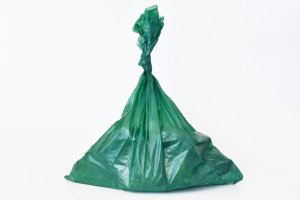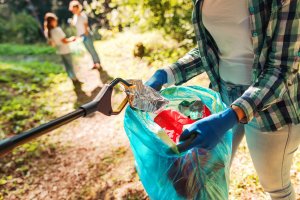Every Day is Earth Day in the Metroparks
April 10, 2024
Erin Parker, Interpretive Services Supervisor
Plastic bottles, granola bar wrappers, juice boxes, plastic bags, aluminum foil, orange peels, pet waste. What do these items have in common? They’re frequently spotted out in the parks in places they don’t belong! As the last bits of winter’s snow melts and before the warmth and light of spring green up the understory, a lot of litter is visible in the leaves, along trails and roads, and collecting along lakeshores and streams.
Litter isn’t just unsightly, it can cause problems for wildlife, block water flow in culverts, and more. What’s a park visitor to do?
Pack it in, pack it out
The best solution is to plan ahead to pack out all the wrappers, cups, bottles, and bags that we bring into the park with us so that they’re not left behind after our hikes and picnics. This doesn’t mean taking the trash all the way home, necessarily, just packing it to the trail head where options for recycling (cardboard, many types of plastic) and waste disposal (food remains, non-recyclable packaging). It is important that only recyclable items end up in the recycling bins because contamination by non-recyclable materials can cause an entire bin to be tossed in the trash.
While it isn’t fun to carry out the soggy sandwich crusts after snack break, even “biodegradable” food waste doesn’t belong out in the parks. Human food can attract pests; turn wildlife aggressive as animals connect people to food; and make animals sick. Fruit peels and cores, while technically biodegradable, can take a long time to break down and aren’t part of our southeastern Michigan ecosystems.

Dog waste can become an issue, as well. Not only is it unpleasant for human visitors to deal with along dog-friendly trails, waste can spread disease and parasites, to dogs, wildlife, and even people. As dog waste breaks down, it washes into the soil and water systems. Parasites such as hookworms and roundworms can live in the soil for years after the original waste has completely broken down. Pet waste should be bagged and disposed of in trash cans, not tossed in the shrubs or left sitting next to trail. One of the most important things responsible pet owners do is make sure that their dog isn’t contributing to the waste problem in our parks!
At picnic areas, plan ahead to dispose of hot coals in the appropriate, labeled containers. Dumping those hot coals on the ground kills the vegetation and can be a safety risk, too. All other trash, including aluminum foil containers, decorations, balloons, and food scraps, should be thrown out or collected for reuse and taken home. Animals like skunks and raccoons quickly learn to frequent picnic areas and campgrounds when people leave their food scraps behind. And they don’t mind that you’ve spent months planning your event if you’re standing in the way of their next meal!

Finally, if you are enjoying a day of fishing in one of the many fishing areas, please take care to properly dispose of fishing line. There are fishing-line specific trash tubes at many sites, and it can also be added to regular trash cans. Fishing line, both strong and nearly invisible, causes harm to birds and other wildlife each year, and many of these animals don’t survive their entanglements, leading to slow deaths due to starvation.
Reduce waste with reusable packaging
Another way to reduce litter is to prevent it in the first place. Consider cloth or silicon bags to store those picnic sandwiches and pre-portioned goldfish crackers. Many interpretive centers and park buildings have water bottle refilling stations so visitors and staff can leave the single-use plastics behind. Stash that lunch in a reusable cooler that can keep leftovers when you’re done.
Climate Action Plan
In late 2023, the Metroparks launched a Climate Action Plan with five key areas to address climate change. One of those five areas focuses on improving waste management, recycling, and composting throughout the parks. While visitor and community input, gathered during the development of the plan, focused on other areas of addressing climate change, staff felt strongly about improving our waste management. With more than 25,000 acres, 200+ staff, and more than 7 million visitors each year, we can do better with our own systems for managing waste, recyclables, and compostable materials as well as be a role model for the best practices for our local communities.
Look for both short-term and long-term changes to waste procedures in your favorite park: from increasing the number and availability of water bottle refilling stations to new composting initiatives in the next five years we hope to make litter a problem of the past!
Earth Day is Every Day in the Metroparks
Park staff and visitors all have roles to play in keeping the parks clean, safe, and litter-free. Litter impacts the experiences we have along trails, in campgrounds, at beaches, at the fishing areas, during picnics, and at the off-leash dog areas. If all remember to properly dispose of all of our waste and that of our pets, the parks will be better for everyone.
If you are interested in participating in an Earth Day clean up event, or learn more about ways to reduce your waste, check out the resources below.

Earth Day Opportunities in Your Metroparks:
- Earth Day Clean Up: Stony Creek takes place on Saturday, April 20 9 a.m.- 3 p.m.
- Earth Day Shoreline Clean-up: Lake Erie takes place on Saturday, April 20 10 a.m.- noon
- Earth Day Cleanup Lake St Clair takes place on Sunday, April 21 10 a.m.- 1 p.m.
For more information or to register for any of the Earth Day clean up events in your Metroparks, please go to our website: metroparks.com and find links to all of our programs under the Things to Do tab.
